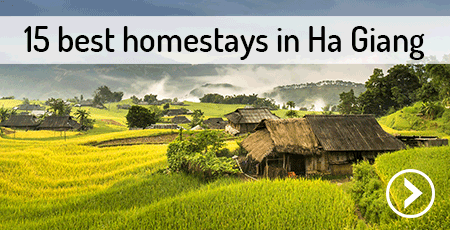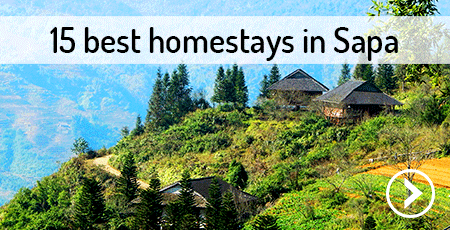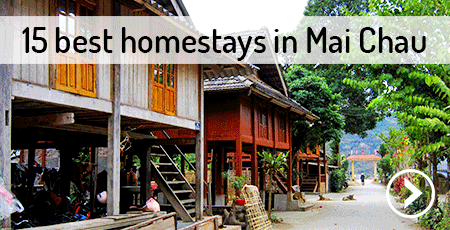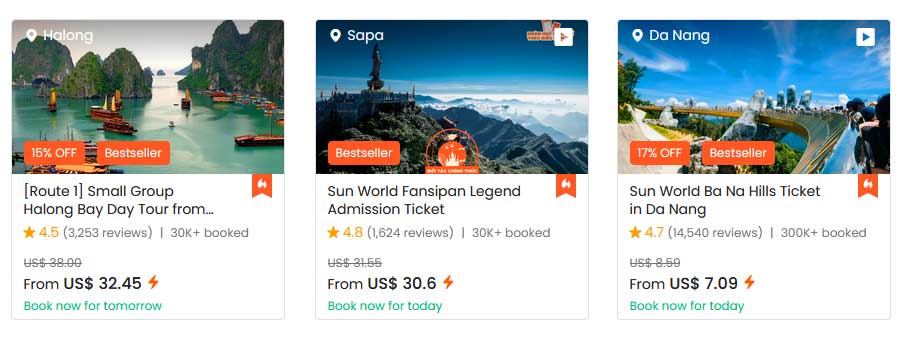
ℹ️ Homestay in Vietnam
📍 Where to Find Homestay
🏠 Types of Homestay
❤️ The Best Homestays
❓ FAQ + Travel Tips / Info
Quick answer: Staying in a homestay in Vietnam is one of the most authentic ways to experience local life. You stay with a Vietnamese family, enjoy home-cooked meals, and get involved in daily routines. It’s a cultural immersion rather than just a place to sleep.
At a glance:
- 📍 Where: Common in rural and mountainous regions (like Sapa or Ha Giang) as well as in the Mekong Delta.
- ⏱️ Stay length: Ideal for 1–3 nights — enough time to join the family in their day‑to‑day life.
- 💰 Price: Very affordable — many homestays cost around US$ 10–30 per night, depending on location and services.
- 🍲 Food: Shared meals are often included — you’ll eat home-cooked Vietnamese dishes made by your host.
- 🤝 Cultural experience: Possibility to join in daily chores, farm work, cooking or local crafts.
- 👲 Community impact: Staying in a homestay supports local families, especially in ethnic minority regions.
- 🌿 Accommodation style: Traditional homes, stilt houses, or simple rural houses — not luxury hotels.
- 🛏️ Facilities: Basic but decent — might include shared bathrooms, limited AC, sometimes communal spaces.
Last updated in November 2025
Homestay in Vietnam is an insight into the daily life of ethnic people.
A popular form of accommodation in some places in Vietnam is homestay with ethnic residents. You live with the locals in their house and you share absolutely everything. Homestay is popular in Vietnam, especially in villages of ethnic minorities. However, you can also try a homestay in a city, for example in Hanoi. It was not allowed for ethnic residents to accommodate foreign tourists some time ago (except for the controlled tourist homestay, for example in Sapa), however now it is gradually changing and tourists are welcome almost everywhere.
1.Immersive Cultural Experience: Staying in an authentic homestay allows you to immerse yourself in the local culture and lifestyle. You’ll have the chance to interact with the host family, learn about their customs, traditions, and daily routines, and gain a deeper understanding of Vietnamese life.
2. Traditional Accommodation: Homestays in Vietnam typically provide traditional-style accommodations, such as wooden stilt houses in rural areas or charming houses in historic towns. These accommodations often feature traditional Vietnamese architecture, with simple yet comfortable rooms furnished with local handicrafts.
3. Warm Hospitality: Vietnamese people are known for their warm and welcoming nature, and staying in a homestay provides an excellent opportunity to experience their hospitality firsthand. The host families are usually eager to share their culture, stories, and home-cooked meals with guests, creating a friendly and inviting atmosphere.
4. Local Cuisine: One of the highlights of staying in a homestay is the opportunity to savor authentic Vietnamese cuisine. Host families often prepare delicious homemade meals using fresh local ingredients, giving you a taste of traditional dishes that may not be readily available in restaurants. You might even have the chance to participate in cooking classes and learn how to prepare Vietnamese specialties.
5. Rural and Natural Surroundings: Many homestays are located in rural areas, surrounded by scenic landscapes, lush rice paddies, and tranquil villages. This provides a peaceful escape from the bustling cities and allows you to connect with nature. You can take part in activities like farming, fishing, or exploring the countryside on bicycle or foot.
HOMESTAY in Vietnam = „Stay with us in our home“
-
- Do you want to know about the daily life of the ethnic population?
- Taste their food?
- Identify some cultural habits?
- Need a local guide?
- Stay on rice terraces or in the mountains?
- Sit with them and drink a rice wine?
- Or talk about anything?
- Do not expect around comfort and luxury?
Did you answered YES? Then surely test the real homestay in a village in northern Vietnam.
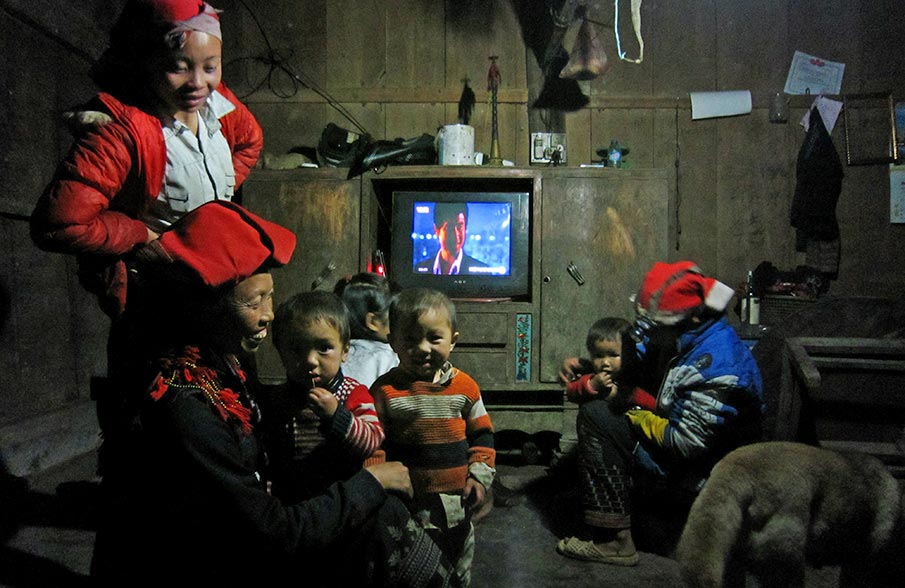
How to ask for homestay and where can I find it?
Just ask people from ethnic minorities. They answer YES or NO, this is simple. Some ethnic people speak English, but not everybody (learn a few basic words in Vietnamese). Ethnic residents have different dialects and their languages. In the area of Sapa, Lao Cai, Mai Chau, Ba Be is not a problem to speak English. In the province of Ha Giang, it is possible that they do not understand, but it depends where you will stay.
Typical homestay accommodation with the ethnic minorities in Ha Giang, Sapa or Mai Chau you can find already on Airbnb, you can book it in advance. Read an article about homestay and villages in Sapa area.
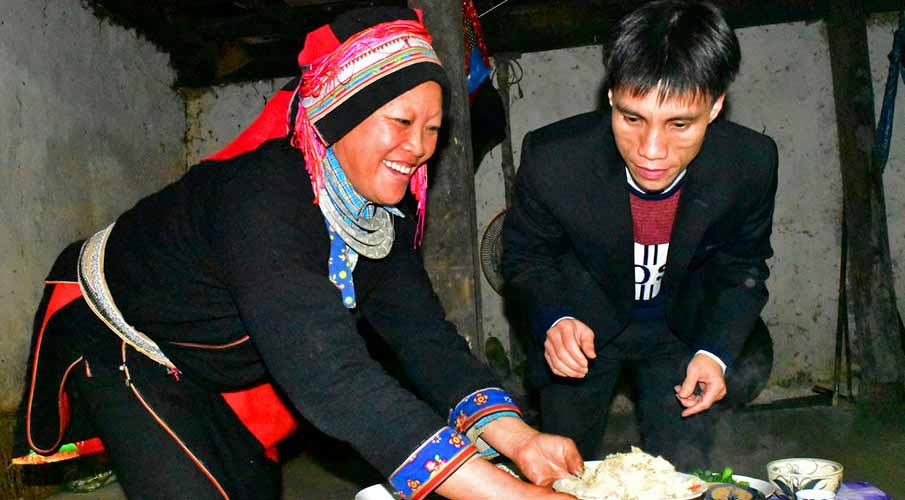
WHO CAN OFFER HOMESTAY IN VIETNAM?
1. Homestay with ethnic minority people in northern Vietnam
-
- A lot of people from the ethnic minorities in a villages in northern Vietnam provides homestay in tourist but also in non-tourist areas. These people are usually not certified guides or employees of travel agencies. It is important that they know very well the place where they live and show you the right places and village life. Some of them have the basic knowledge of English, others speak English very well. They learn the English from the tourists who visit them. Communication is usually not a problem. If there is a communication problem, use your hands, or feet, you can also use Google translator.
-
- For a high rate of authenticity it is recommended to try homestay accommodation with locals. But you must forget for the comfort and luxury around. Do you want to see the hard work in the rice fields or even try it, see how they kill a pig, or attend a wedding or funeral, to see how the local people make clothes? If so, you leave this place and Vietnam with experiences!
-
- It is good to know, you give the money for the residents of the village and not the agencies and resellers. I participated myself in the New Year’s Eve in the Hmong village. It was not evening, which we are accustomed, but I took an unforgettable experience. Another interesting experience was the funeral in a village of White Thai ethnic minority in Mai Chau town.

2. Homestay from a travel agency from northern Vietnam
-
- Tourist agencies and offices also offer homestay. These offers differs from the real type homestay, which offer local ethnic residents. A lot of foreign tourists use this type mainly due to good facilities and services. The working people can be from the some ethnic minority, but they have abandoned their traditions and customs and are employed by the Vietnamese agency.
-
- This offer is often associated with the offer on trekking, after the trek they will take you to the imitation of true type homestay. But this house is very different from the true type of house of local residents. Do you think, that poor ethnic residents have WiFi, european style toilet, shower or even a bar next to the house? I think, they dont have almost anything. These treks and trips are managed in group of 6 to 10 people.
3. Homestay also offers local people in Vietnam
-
- The offer includes the apartments in a house with another family, or roommates, for example in Hanoi or Ha Long. If you want to try out these offers, some can be found on Airbnb, Homestay, Agoda.
Book your homestay in Vietnam on these verified websites:

HOMESTAY ACCOMMODATION – TYPES OF HOUSES:
In northern Vietnam during your traveling you can see 4 types of homestay house:
1. The real homestay in a village of ethnic minorities
-
- most of the houses are build of the wood and bamboo
- simple sanitary facilities (no sink-only mountain water pipe, asian toilet)
- sometimes is no WiFi, sometimes is WiFi
- food is prepared on an open fire
- there is no heating
- a hard wooden beds, but with a warm blanket
- authentic atmosphere of village life
- location off the tourist trail
- people are not „mascots“ (they walk in traditional costumes and use old habits)
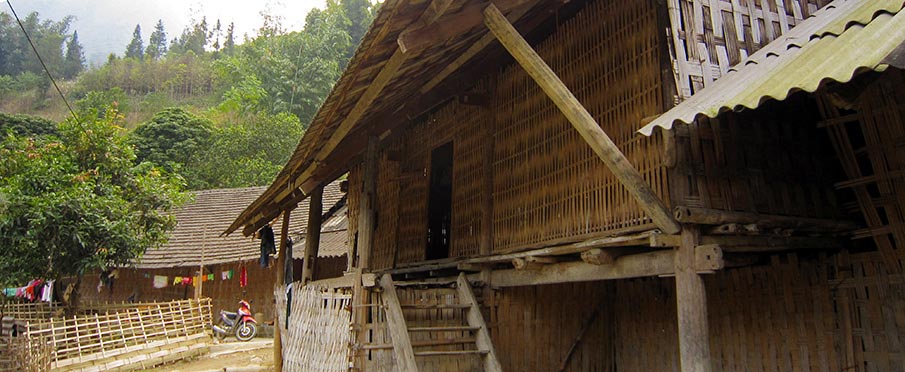
2. Homestay in more tourist village or area
-
- houses can be build of wood but also of bricks
- generally adapted housing into newer form
- some places have WiFi
- shower and toilet of european style
- some houses have heater
- food is prepared in the classic kitchen
- authentic atmosphere is a little bit missing
- locations in more tourist village or area
- people may be from ethnic minorities, but they do not behave so (traditional clothes and customs missing)
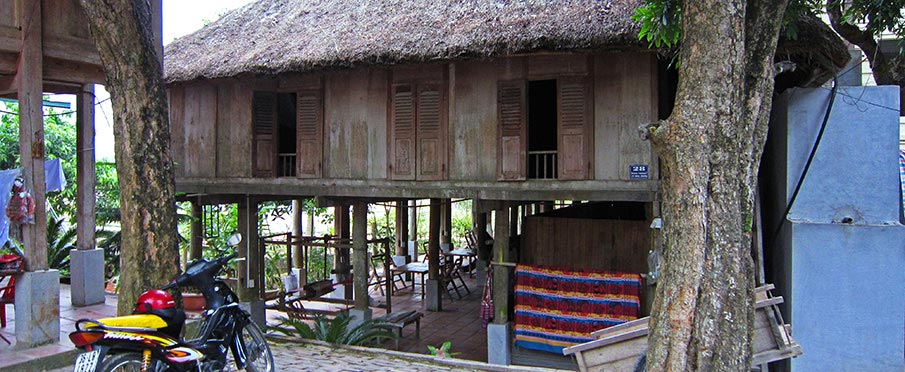
3. Homestay in a tourist spot and area
-
- houses can be build of wood but also of bricks
- new or renovated homes or cottages
- WiFi internet
- shower and toilet of european style
- heaters
- food is prepared in the classic kitchen
- authentic atmosphere of village life is missing
- location in the tourist village or area
- employees are typical Vietnamese people
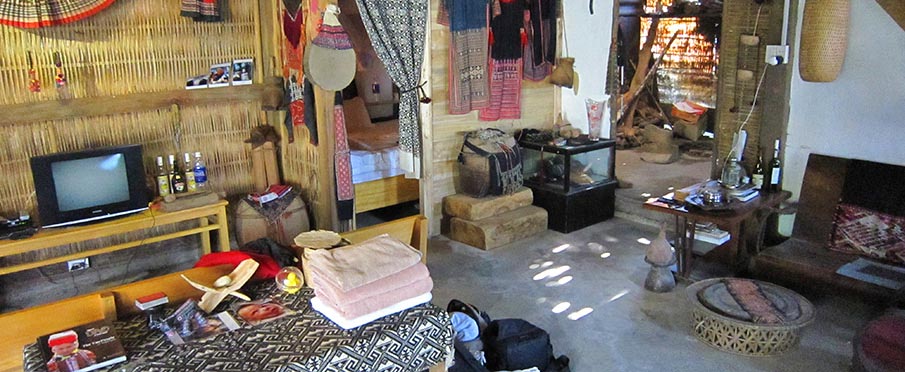
4. Homestay offers typical vietnamese families
-
- separate rooms or entire homes and roommates
- mostly in urban areas (Hanoi, Ha Long)
- older and new brick houses
- all facilities and restrooms what you know
- good availability in the city
HOW WAS ONE DAY OF MY HOMESTAY in Hau Thao village:
My first homestay in northern Vietnam, I tried the 2nd day since I arrived in Sapa. Sapa is very popular for homestay and a lot of travelers come here for trying this. Already in the first day I’ve already learned that it is not important to search for some guide. There are a lot of women and girls from ethnic Hmong and Red Dao minority in Sapa town, and they offer their services (trekking, homestay). And you recognize their entrepreneurial spirit already upon arrival to Sapa 🙂 Constantly they are offering a trekking around the town, homestay or sale of handmade items and accessories. Personally I have no problem with that, but if it is repeated in the next days, it can be annoying for some people, you have to learn to ignore it. Get ready for it, especially in Sapa town!
Her short name is Cha and she speaks decent English.
So, the next day I went into the center in Sapa and just walked and i was looking for some ethnic woman I address. After a few minutes I address a woman who was standing and talking with her friend. She was quite all smiles and after a short conversation, I knew she is from this place and knows very well this area. But check out the photo below, I think she is very nice 🙂
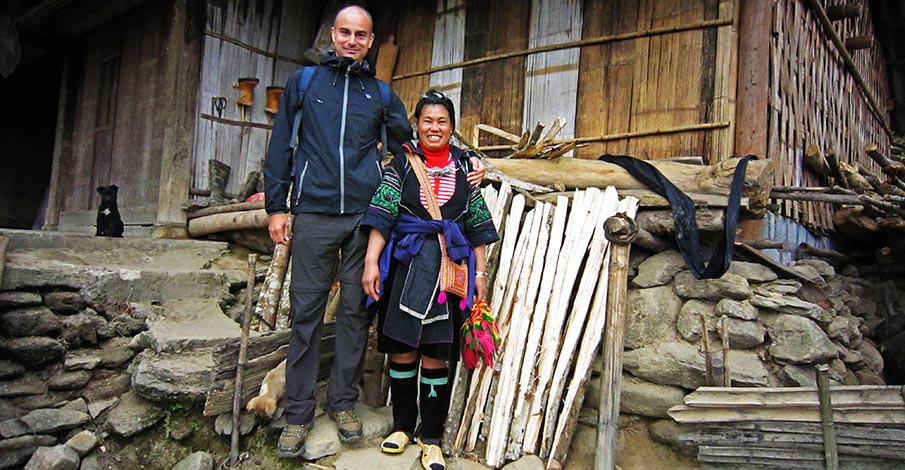
Trekking with the local people is the best – they know the local area.
I asked her, I would like to go around Sapa and try stay overnight in a village with minority people. This is usually the classic offer of these women – trekking and homestay. She offer me this service for 10 USD, I accept it and ask for details, where we are going and what is included. I do not want go to the Cat Cat or Tavan village, because these places are very frequented with tourists. We are going the unofficial trek around the eastern part of Ham Rong mountain, to the Hau Thao village, where i spend a night with her family. Hau Thao village is about 2 km from Tavan, but almost nobody here do not go here on a homestay. In addition, we are going to a place, where is no need to buy a ticket as to other villages.
Photos of Hau Thao trek
Homestays in the north of Vietnam (Ha Giang, Sapa, Mai Chau, Ninh Binh) ➜
Rubber sandals for the trek? “No problem”.
The first things i notice are rubber sandals in which Cha goes. It is for me absolutely unimaginable to go about 13 km in these shoes, but for these women it is completely normal. But it is also affected by the financial possibilities of the ethnic population, because they are very limited. The way is about 13 km long in the complicated terrain, 3 km are up the hill along the Dragon Mountain. From the mountains is the way a little bit better, but sometimes there are stones, mud, dirt roads. Along the way we talk, I’m curious, so I ask her for things, but after a while I see, Cha is already a little bit tired of my questions 🙂 She speaks English, I know what does she say.
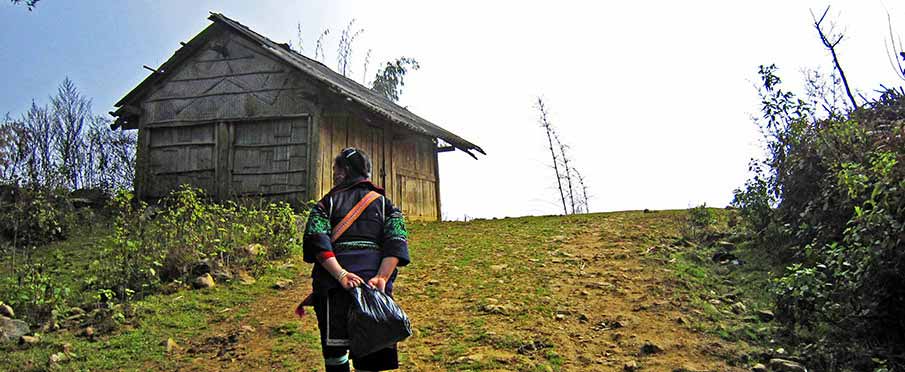
The Stand where Cha is buying tangerines, seems to fall today.
Along the way we have a few breaks, and I love photographing. There are fantastic sceneries – sharp stones projections with hills alternate with distant views into the depths of a mysterious fog between hills. Along the way we pass three small villages, people live here a bit away from civilization, authenticity is high – ethnic Hmong residents in colorful costumes prevail. When they see me, they laugh. People talk to Cha in optimistic spirit, the people here know each other. We stop at some stand, it look like fall today and Cha buy some tangerines and some snack on the way.
How to travel from Hanoi to Sapa? ➜
Book your hotel / homestay in Sapa ➜
Most of the ethnic people lives in limited poor conditions.
After about 4 hours, we come to the village of Hau Thao. It’s a nice place, small village on a gentle hillside with a view to the valley and to the Tavan village and Muong Hoa valley. The village lies on the way to Ban Ho. Cha has two small children, 7 and 10 years, they are at home because they do not have money to be able to walk to school. She shows me their house and neighbors around them. I was quite in shock, house is very modest, there is practically nothing and everything is mostly build of wood – it looks like middle ages. Poverty and misery are shown in full glory.
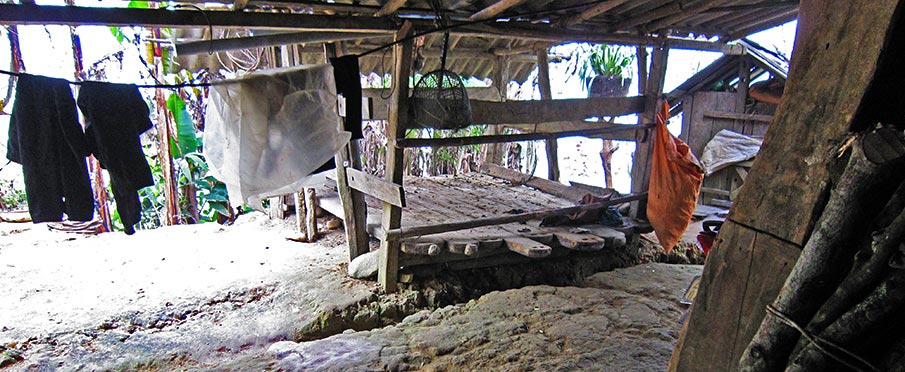
Water flows into the house with a rubber hose from the mountains.
Kitchen = fireplace, toilet – viet.style, water is heading from a rubber hose, which is led from a mountain stream. Of course only a cold water, there is no shower and sink, but there is electricity. The house is made of wood except of the roof, the floor is trampled hard soil, but there are a half-meter brick pedestals. At the entrance is a small barn for water buffalos, a small barn next to the house for pigs. They have here some chickens, ducks and 3 small dogs and five pigs. And they have also satellite television.
How to travel from Hanoi to Ha Giang? ➜
Book your hotel / homestay in Ha Giang ➜
Welcome to the Middle Ages. Hot food is prepared on a fire.
After a while Cha begins to prepare the food for her and for me. She cooks pork with vegetables, tofu and rice. Food is preparing on fire. It is very good, the meat is very tasty and rice is delicious. When we finish, we go look around the village and then to the Tavan village. Many Hmong and Red Dao people lives here. In Tavan we go look for her sister, who lives outside the tourist route. Actually, we are in Hoang Lien National Park. Beautiful surrounding, mountains and scenery are everywhere. The evening comes slowly and we go back to Cha´s home, her husband is waiting for her. He can not speak English, Cha translates some of my sentences for him.
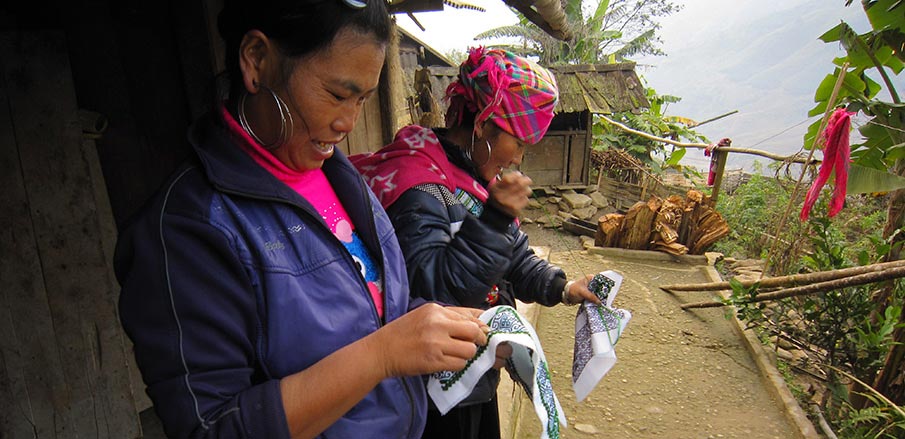
Ethnic people will be pleased to prepare their typical dishes.
For dinner with the whole family we eat what was left from lunch, food is almost similar. Everyone in the family can talk and discuss the experiences of the day. Cha translates something for me when I do not understand. They show me some photos of other travelers from around the world who visited them. And some pictures of the family circles, photos are really interesting. This evening ends slowly and we drink a rice wine, they drink the rice wine almost every day.
How to get from Hanoi to Cao Bang? ➜
Book your hotel / homestay in Cao Bang ➜
You can also sleep in the attic. But there is really cold in the winter.
My bed is on the ground among the bags of rice. There is a pad that is not too hard but i have very warm and clean blanket from the family. I´am quite sleepy. Some animal is scraping on the roof of the dwelling. It is quite a cold winter. But otherwise I sleep quite well. I wake up in the morning around 8 o’clock, the whole family is already up from 6 pm. Cha with her friend embroider some blankets for tourists and her husband is somewhere in the woods. Children play around the house and also help with the housework.

Homestay is a great experience and I need to recommend it to anyone.
And this is the end of my homestay experience. It is about 10 am and I´am leaving. I know that I will come back again. I came back unexpectedly on New Year’s Eve, when I was invited here to celebrate with family. But that’s another story.
I really enjoyed homestay in Hau Thao in northern Vietnam, people were friendly, it was a great lesson for me. I saw how people live in absolute poverty without a large income. I know that the life of these people is difficult, it seems to me that they are satisfied with this. But the optimism and smile of local people in Vietnam, which I felt and saw there among the people was really magical.
❓ Frequently Asked Questions about Homestay in Vietnam:
1. How to book a private tour or other activity in Vietnam?
-
- You can search and book various private tours, tourist activities or tickets for attractions in Vietnam with KLOOK.
2. How to book homestay in Vietnam?
3. What to expect from homestay in Vietnam?
-
- Homestay in Vietnam is an ideal opportunity, how you can see typical life of ethnic people from northern Vietnam. You can try food, you can explore an area with these people and you can stay with them in their home.
4. How to get to Sapa from Hanoi?
-
- From Hanoi to Sapa you can travel by various ways of transport, there is no flight. You can travel by tourist bus or you can take a sleeper train to Lao Cai and public bus from Lao Cai to Sapa. Travel time by bus is about 6 hours.
5. What is the price of homestay in Vietnam?
-
- It depends what type of homestay you will choose and book. Prices start at 5-10 USD for shared bed or you can also take a private room for about 15-20 USD.
6. Where you can try homestay in northern Vietnam?
7. Is there a wi-fi in homestay in Vietnam?
-
- It depends where you will stay. If you stay at the mountain areas of northern Vietnam, there is no wi-fi, but if you will stay close to the town, there should be a wi-fi.
8. What is an authentic homestay experience in Vietnam?
-
- An authentic homestay in Vietnam offers travelers the opportunity to stay with local families in traditional villages or rural areas. It provides a unique cultural immersion experience, allowing visitors to live with and learn from the locals, participate in their daily activities, and gain insights into their customs, traditions, and way of life.
9. What are the benefits of choosing an authentic homestay in Vietnam?
-
- Opting for an authentic homestay in Vietnam allows you to go beyond the typical tourist experience and connect with the local culture on a deeper level. It promotes sustainable tourism by supporting local communities, preserving traditional customs, and generating income for the host families. Additionally, you have the opportunity to learn new skills, gain a better understanding of local traditions, and create meaningful connections with the people you encounter during your stay.
10. What should I pack for an authentic homestay in Vietnam?
-
- For an authentic homestay in Vietnam, pack lightweight and breathable clothing suitable for the local weather. Comfortable walking shoes or sandals are essential for exploring the surroundings. Don’t forget to bring insect repellent to protect yourself from mosquitoes. Pack your own toiletries and personal essentials, as well as a travel adapter for charging your electronics. It’s also advisable to carry cash and small denominations for convenience.
BOOK A TOUR / ACTIVITY in Vietnam ➜
Popular Places for Authentic Homestays in Northern Vietnam:
| Popular Places for Authentic Homestays in Northern Vietnam: | Details |
|---|---|
| 1. Sapa Valley: |
Immerse yourself in the rich culture of Sapa’s ethnic minority communities. Homestays here offer a genuine experience, allowing you to interact with local H’mong and Dao people. Wake up to stunning views of terraced rice fields and embark on guided treks to explore the surrounding landscapes. |
| 2. Ha Giang Highlands: |
Experience the breathtaking landscapes and vibrant culture of the Ha Giang province. Homestays in this mountainous region provide an authentic connection with the Tay, H’mong, and Dao communities. Engage in local traditions, enjoy home-cooked meals, and witness the beauty of the Dong Van Karst Plateau. |
| 3. Cao Bang’s Ethnic Villages: |
Explore the ethnic villages of Cao Bang for a unique homestay experience. Stay with local families in traditional houses, surrounded by lush landscapes and serene rivers. Engage in cultural exchanges, visit the Ban Gioc Waterfall, and savor the hospitality of the Nung and Tay communities. |
| 4. Mai Chau’s Stilt Houses: |
Escape to the peaceful landscapes of Mai Chau, known for its stilt houses amidst rice paddies. Homestays in Mai Chau offer a serene retreat with the opportunity to connect with the Thai ethnic group. Engage in traditional dances, sample local cuisine, and unwind in the tranquility of nature. |
| 5. Bac Ha in Lao Cai: |
Discover the vibrant markets and authentic homestays in Bac Ha. Stay with Flower H’mong families, known for their colorful attire. Explore the bustling markets, where you can witness the lively trading of local products and traditional handicrafts. Bac Ha offers a unique blend of cultural immersion and market experiences. |
| 6. Yen Bai’s Thac Ba Lake: |
Experience homestays along the shores of Thac Ba Lake in Yen Bai. Stay in traditional houses, enjoy boat rides on the lake, and interact with the Dao communities. Thac Ba Lake provides a tranquil setting for cultural exploration, surrounded by lush greenery and water reflections. |
| 7. Pu Luong Nature Reserve: |
Embark on an authentic homestay adventure in the heart of Pu Luong Nature Reserve. Stay in traditional Thai stilt houses, surrounded by terraced fields and lush forests. Engage with local communities, trek through the reserve’s scenic landscapes, and experience the serenity of Northern Vietnam. |
| 8. Ban Gioc Waterfall Surroundings: |
Explore homestays near the majestic Ban Gioc Waterfall. Stay with local families, enjoy the sounds of nature, and witness the beauty of Vietnam’s most impressive waterfall. The surrounding area offers a peaceful retreat with opportunities for cultural exchanges and natural exploration. |
| 9. Haiphong’s Cat Ba Island: |
Combine island life with authentic homestays on Cat Ba Island in Haiphong. Experience the unique blend of coastal charm and local hospitality. Engage in water activities, explore the island’s natural beauty, and enjoy the relaxed atmosphere of this Northern Vietnamese gem. |
| 10. Lang Son’s Dong Khe: |
Discover the historical significance of Dong Khe in Lang Son province through authentic homestays. Stay in the midst of lush landscapes, explore historical sites, and engage with the local communities. Dong Khe offers a unique combination of cultural heritage and Northern Vietnamese hospitality. |
Staying in an Authentic Homestay in Vietnam – Pros / Cons:
| Pros | Cons |
|---|---|
| Immersive cultural experience: Staying in an authentic homestay allows you to immerse yourself in the local culture, interact with the host family, and gain insights into traditional customs and ways of life. | Basic amenities: Some homestays may have limited facilities compared to hotels, such as shared bathrooms, basic furnishings, and simple accommodations. |
| Authentic meals and local cuisine: Homestays often provide homemade meals using fresh local ingredients, giving you the opportunity to savor authentic Vietnamese cuisine and traditional dishes. | Potential language barrier: Communication can be a challenge if the host family doesn’t speak fluent English, which may make it difficult to express your needs or ask for assistance. |
| Personalized hospitality: Homestay hosts are usually warm and welcoming, providing personalized attention and sharing their local knowledge, recommendations, and insider tips to enhance your travel experience. | Possible limited privacy: Since you are staying in a family’s home, you may have less privacy compared to a private hotel room, as common spaces might be shared with other guests or family members. |



